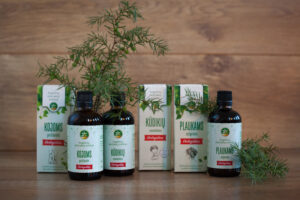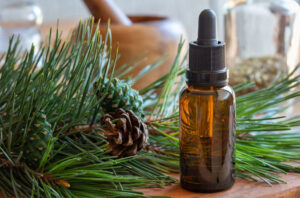Chamomile is one of the most well-known and widely-used medicinal herbs. Chamomile, also referred to as camomile or scented mayweed, was already used by doctors in the ancient Greece and Rome. The Latin word matrix stands for “womb”. During the Middle Ages chamomile was used to treat women’s ailments and this is probably where the Latin word comes from.
Tea is made only of chamomile blossoms. High-quality harvest requires a lot of hand work with dryers close to the plantations, because the process of drying must begin no later than 2-3 hours after harvesting, otherwise the herbs go bad and become unsuitable to use.
Blossoms accumulate 0.31-0.54 % of the blue essential oil, which mostly consists of azulene (chamazulene) (up to 85.40 mg%), also terpene, sesquiterpene, sesquiterpene alcohols and cadinene. Moreover, blossoms also contain apigenin, matricine, dioxicoumarin, lactone, matricarine, nicotine, salycil, isovaleric and fatty acids, about 33 mg% of vitamin C, caroten, mucus, bitter substances, up to 12 % of minerals and other compounds.
Chamomile essential oil and extract are widely used in perfume making. They are also a popular ingredient in creams, shampoos and lotions.
Chamomile blossoms are great for rinsing hair, making them shiny and flexible. Being a natural dye, they are perfect for blondes.
The blossoms give the hair a yellowish shade.
Chamomiles also have been used as an insect repellent and people used to put them into mattresses. When spending time in nature, rub your skin with chamomile tea in order to repel mosquitoes.
Chamomile harvest time comes when plants have 5-10 flat blossoms. If the blossoms are cone-shaped, then harvesting is too late. Depending on the intensity of blooming, blossoms can be harvested 2-5 and more times. Harvesters work with their hands or a special metal comb, attached to a box. The comb must have specific density and the box needs to be light and convenient. The stems cannot exceed 3 cm.
Fresh blossoms cannot be kept in baskets or piles for more than 2-3 hours, because they heat up and turn black as they dry. The raw material must be spread on paper-covered shelves or sieves in a thin layer (1 kg of blossoms requires 1 m2 area) and dried in a well-ventilated shade. If the weather is good, herbs dry out in 5-7 days. The temperature in a special heated dryer cannot exceed 45 oC.
Dried blossoms must be sturdy, 4-8 mm in length and 4-8 mm in width, yellowish green with white tongue-like petals and stems that are not longer than 3 cm, characterised by a strong smell, slightly bitter taste and a bit mucous. Dried herbs should contain no more than 14 % moist, no more than 8 % of blossoms with 3-5 cm stems, no more than 5 % of brownish or black blossoms, no more than 20 % of crumbled blossoms, falling through a 1 mm sieve, no more than 1 % of stems and leaves, no more than 1 % of organic additives, no more than 0.5 % mineral additives and at least 0.3 % of essential oil. Herbs can be stored for up to one year.
Just like other preparations, chamomile tea is used to relieve gastric cramps, diarrhoea, stimulate perspiration, mouth rinsing and washing wounds as an antiseptic. Strong blossom brew is used as a hair dye and a disinfectant for scalp. Sometimes blossoms are used in perfume or liquor making.
Literature
Butkus, V., et. al. Mažieji miško turtai. Vilnius: Mokslas 1987.
Čekauskaitė, L. Gamtos vaistinėlė. Kaunas: Spindulys, 2003.
Kaunienė, V.; Kaunas, E. Vaistingieji augalai. Žinynas. Kaunas: Varpas, 1991.
Obelevičius, K; Petkevičiūtė, S; E. Šeinauskienė, E. Prieskoninių augalų ir jų vartojimo žinynas. Kaunas: Lututė, 2011.
Ragažinskienė, O.; Rimkienė, S.; Sasnauskas, V. Vaistinių augalų enciklopedija. Kaunas: Lututė, 2005.





